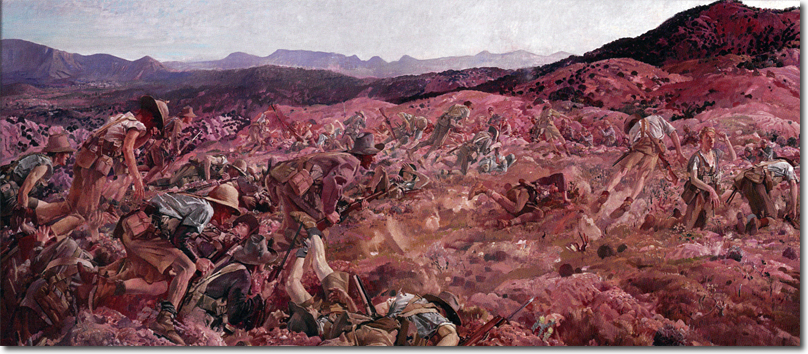|
|


|
|
Though no-man's land at the Nek was at most 55 metres
(60 yards) wide, eight lines of trenches stepped back from
it to Baby 700, and German Officers' Trench at Anzac
enfiladed it. Birdwood knew that attacking from the Nek
unaided would be suicidal. As a feint against German
Officers' had just been shredded, he now recognized that
the Nek attack would indeed be unaided, but reasoned that
it might distract the Turks and help the New Zealanders
take Chunuk Bair. The risk to the light horse was dire, but
he and Godley deemed it justified.
At 4.30 a.m., after a 30-minute bombardment, four waves, two each from the 8th and 10th Light Horse Regiments, would assault. Each wave comprised 150 men, the widest frontage that could fit on the Nek. But the bombardment inexplicably ceased seven minutes early. The Turks were seen emerging from their shelters to sit on the parapet or stand behind it. The light horsemen awaited a final flurry of shells. None came. Knowing it was doomed, the first line nonetheless assaulted as planned. A tornado of fire, described as noisier than thousands of policemen's rattles, annihilated it. The high command had called wrongly, but what followed was the fault ofthe local command. Brigadier General Fred Hughes, the 3rd Light Horse Brigade's commander, had been a successful militia officer in Australia but was found wanting like several of his peers by the rigours of war at Anzac. Elderly and ill he left things to his brigade-major, Lieutenant Colonel Jack Antill a career officer known as 'Bullant' partly because of his bullying ways . Though the 1st Light Horse Brigade's simultaneous feint at Quin's had just been stopped after the first of its four lines had been wiped out Antill heard that the first line at the Nek had left a marker flag on the Turkish parapet. I indicated to him that the parapet had been reached not that someone had also beaten the odds to get there. Without going forward to see for himself, and dismissing protests that to continue amounted to murder, he ordered the attacks to go on. Hughes watching from an observation post and thoroughly rattled did nothing. Knowing they had just minutes to live those in the other three lines took a last look at photos of loved ones, pinned wedd ing rings and other precious keepsakes to the trench wall and bid one another farewell. When the whistles sounded they went with a cheer. Dead and wounded carpeted an area the isze of three tennis courts afterwards. Of the 372 light horse casualties 234 had been killed almost immediately. Turkish losses were negligible. The image of men whose bravery made them go unflinchingly to certain death evoked both pride and sadness and seared the charge or more correctly the sacrifice at the Nek into Australian consciousness. That sacrifice had nothing to do with helping the sluggish British landing at Suvla, as Australian director Peter Weir's 1981 film Gallipoli implied. It had everything to do with helping the New Zealanders at Chunuk Bair. Painting by George Lambert |
Armed Forces | Art and Culture | Articles | Biographies | Colonies | Discussion | Glossary | Home | Library | Links | Map Room | Sources and Media | Science and Technology | Search | Student Zone | Timelines | TV & Film | Wargames